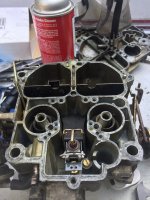Hello everyone.
Can somebody explain (or point me to the appropriate information source) how the fuel injection system works on the 5.7 Gi engines? I have 1997 Pursuit 2460 that had the original engine replaced by previous owner. The original engine was 5.7GIPLKDCE, i.e. fuel injected. The replacement engine is carbureted. To make things worse, the carburetor was later replaced by Edelbrock 1409. I am hating this carb, it made cold starts after long (over a week) periods of sitting at the dock a real pain. So, instead of buying a new carb I am contemplating going back to fuel injection. Naturally, I am trying to understand the original setup first. In particular, I have two questions:
1. I do not see any oxygen sensors in 5.7GIPLKDCE diagrams (even though there appears to be a knock sensor). Is this correct?
2. What is the deal with the fuel reservoir? I get it that it was used for fuel return from high pressure fuel pump. What's the deal with hoses connecting it to thermostat housing and risers? Does it have water circulating through it somehow? There also appears to be a float inside the reservoir, how does this work?
Can somebody explain (or point me to the appropriate information source) how the fuel injection system works on the 5.7 Gi engines? I have 1997 Pursuit 2460 that had the original engine replaced by previous owner. The original engine was 5.7GIPLKDCE, i.e. fuel injected. The replacement engine is carbureted. To make things worse, the carburetor was later replaced by Edelbrock 1409. I am hating this carb, it made cold starts after long (over a week) periods of sitting at the dock a real pain. So, instead of buying a new carb I am contemplating going back to fuel injection. Naturally, I am trying to understand the original setup first. In particular, I have two questions:
1. I do not see any oxygen sensors in 5.7GIPLKDCE diagrams (even though there appears to be a knock sensor). Is this correct?
2. What is the deal with the fuel reservoir? I get it that it was used for fuel return from high pressure fuel pump. What's the deal with hoses connecting it to thermostat housing and risers? Does it have water circulating through it somehow? There also appears to be a float inside the reservoir, how does this work?




















